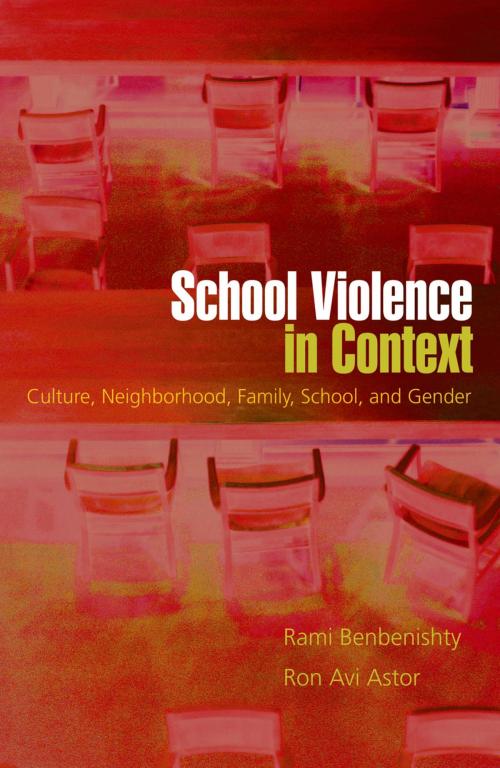School Violence in Context
Culture, Neighborhood, Family, School, and Gender
Nonfiction, Social & Cultural Studies, Social Science, Social Work, Reference & Language, Education & Teaching, Educational Theory, Educational Reform| Author: | Rami Benbenishty, Ron Avi Astor | ISBN: | 9780190289089 |
| Publisher: | Oxford University Press | Publication: | February 10, 2005 |
| Imprint: | Oxford University Press | Language: | English |
| Author: | Rami Benbenishty, Ron Avi Astor |
| ISBN: | 9780190289089 |
| Publisher: | Oxford University Press |
| Publication: | February 10, 2005 |
| Imprint: | Oxford University Press |
| Language: | English |
Drawing on one of the most comprehensive and representative studies of school violence ever conducted, Benbenishty and Astor explore and differentiate the many manifestations of victimization in schools, providing a new model for understanding school violence in context. The authors make striking use of the geopolitical climate of the Middle East to model school violence in terms of its context within as well as outside of the school site. This pioneering new work is unique in that it uses empirical data to show which variables and factors are similar across different cultures and which variables appear unique to different cultures. This empirical contrast of universal with culturally specific patterns is sorely needed in the school violence literature. The authors' innovative research maps the contours of verbal, social, physical, and sexual victimization and weapons possession, as well as staff-initiated violence against students, presenting some startling findings along the way. When comparing schools in Israel with schools in California, the authors demonstrate for the first time that for most violent events the patterns of violent behaviors have the same relationship for different age groups, genders, and nations. Conversely, they highlight specific kinds of violence that are strongly influenced by culture. They reveal, for example, how Arab boys encounter much more boy-to-boy sexual harassment than their Jewish peers, and that teacher-initiated victimization of students constitutes a significant and often overlooked type of school violence, especially among certain cultural groups. Crucially, the authors expand the paradigm of understanding school violence to encompass the intersection of cultural, ethnic, neighborhood, and family characteristics with intra-school factors such as teacher-student dynamics, anti-violence policies, student participation, grade level, and religious and gender divisions. It is only by understanding the multiple contexts of school violence, they argue, that truly effective prevention programs, interventions, research agendas, and policies can be implemented. In an age of heightened concern over school security, this study has enormous implications for school violence theory, research, and policy throughout the world. The patterns that emerge from the authors' analysis form a blueprint for the research agenda needed to address new and exciting theoretical and practical questions regarding the intersections of context and school victimization. The unique perspective on school violence will undoubtedly strike a chord with all readers, informing scholars and students across the fields of social work, psychology, education, sociology, public health, and peace/conflict studies. Its clearly written and accessible style will appeal to teachers, principals, policy makers and parents interested in the authors' practical discussion of policy and intervention implications, making this an invaluable tool for understanding, preventing, and handling violence in schools throughout the world.
Drawing on one of the most comprehensive and representative studies of school violence ever conducted, Benbenishty and Astor explore and differentiate the many manifestations of victimization in schools, providing a new model for understanding school violence in context. The authors make striking use of the geopolitical climate of the Middle East to model school violence in terms of its context within as well as outside of the school site. This pioneering new work is unique in that it uses empirical data to show which variables and factors are similar across different cultures and which variables appear unique to different cultures. This empirical contrast of universal with culturally specific patterns is sorely needed in the school violence literature. The authors' innovative research maps the contours of verbal, social, physical, and sexual victimization and weapons possession, as well as staff-initiated violence against students, presenting some startling findings along the way. When comparing schools in Israel with schools in California, the authors demonstrate for the first time that for most violent events the patterns of violent behaviors have the same relationship for different age groups, genders, and nations. Conversely, they highlight specific kinds of violence that are strongly influenced by culture. They reveal, for example, how Arab boys encounter much more boy-to-boy sexual harassment than their Jewish peers, and that teacher-initiated victimization of students constitutes a significant and often overlooked type of school violence, especially among certain cultural groups. Crucially, the authors expand the paradigm of understanding school violence to encompass the intersection of cultural, ethnic, neighborhood, and family characteristics with intra-school factors such as teacher-student dynamics, anti-violence policies, student participation, grade level, and religious and gender divisions. It is only by understanding the multiple contexts of school violence, they argue, that truly effective prevention programs, interventions, research agendas, and policies can be implemented. In an age of heightened concern over school security, this study has enormous implications for school violence theory, research, and policy throughout the world. The patterns that emerge from the authors' analysis form a blueprint for the research agenda needed to address new and exciting theoretical and practical questions regarding the intersections of context and school victimization. The unique perspective on school violence will undoubtedly strike a chord with all readers, informing scholars and students across the fields of social work, psychology, education, sociology, public health, and peace/conflict studies. Its clearly written and accessible style will appeal to teachers, principals, policy makers and parents interested in the authors' practical discussion of policy and intervention implications, making this an invaluable tool for understanding, preventing, and handling violence in schools throughout the world.















